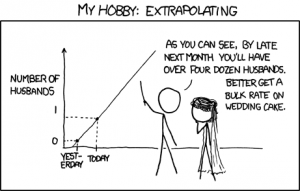Extrapolation Comic Strips
Here are a few comic strips dealing with extrapolation. Each is accompanied by a question I would ask students about the strip.
1) Explain this comic strip using knowledge from the course.
(This strip is by Randall Munroe and can be accessed at http://xkcd.com/605/)
2) Read this comic strip by Randal Munroe and answer the following questions.

(This strip can be accessed at http://xkcd.com/1007/)
a) For which span of years does the Munroe have data on the frequency of the use of the word “sustainable”?
b) Munroe made a model of this data. Does the model fit the data well?
c) Munroe used his model to predict the frequency of the word “sustainable” in 2061. What percent of words does he predict will be ”sustainable” in 2061? Is this an example of interpolation or extrapolation? Is this prediction likely to be valid?

2:48 pm - 5-13-2023
The article discusses two comic strips by Randall Munroe, which deal with the concept of extrapolation. The first comic strip involves algebra and modeling, while the second one focuses on the frequency of the use of the word “sustainable” over time.
In the first strip, Munroe humorously highlights the dangers of extrapolation, which involves extending a trend or pattern into the future beyond the data available. The strip illustrates how an incorrect assumption about the nature of a trend can lead to absurd and unrealistic predictions.
In the second strip, Munroe analyzes the frequency of the use of the word “sustainable” over time and creates a model to predict future usage. Munroe’s model suggests that the use of the word “sustainable” will continue to increase in the future, albeit at a slower rate. Munroe’s prediction for the frequency of the word “sustainable” in 2061 is extrapolation, as it extends beyond the range of available data. However, the validity of this prediction is questionable, as it is unclear whether the trend in the use of the word “sustainable” will continue into the future.
Overall, these comic strips provide an engaging and humorous way to introduce the concept of extrapolation and its limitations. It encourages readers to be critical of predictions based on extrapolation and to consider the validity of underlying assumptions and trends.